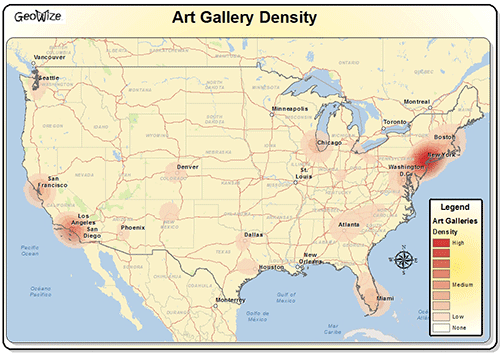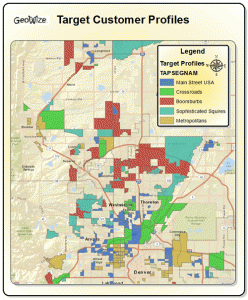GIS for the Creative Industries
by Wayne Kocina/GeoWize [email protected]

A chart of art gallery density in the United States. Data and image by Wayne Kocina / GeoWize.
For many artists, their art comes first, and being in business is an afterthought. Artists who want to be successful need to view themselves and their art as a business. Every business, whether they sell to consumers, other businesses, or both, needs to know who its customers are, where they are located, and where to find more like them. The businesses also need to understand the competitive landscape.
GIS (Geographic Information Systems) analysis can provide creative artists with insight into all of these elements and help them be successful.
What is GIS or Geographic Information Systems?
GIS takes geography and specific locations, the information about those locations and the people or businesses associated with those locations, and provides analysis and unique visualization of complex data and relationships that allows the business owner to make critical decisions that affect their potential for success.
GIS analysis can provide answers to questions like: Where is the best location for my businesses? What are my customers like? Where can I find more good customers? How big is the market for my product or service? Where do I need to locate my warehouses? Where should I have distributors? Where is my competition, and who is my competition?
How does this work? As an example, let’s study an artist that paints horses. This artist sells to consumers directly from his studio and at art shows. He also works through galleries, possibly those that specialize in western art and to related businesses like veterinarian offices, tack shops and related associations, like the Western Stockmen’s Association and the Professional Rodeo Cowboy’s Association.
Consumers – Analysis has revealed that the types of consumers who typically purchase original art are financially well off and live in higher value homes. They may live in urban, suburban, or rural areas. Sophisticated segmentation or consumer profiling systems can be utilized to precisely find more potential clients. Additionally, if the artist has an address list of customers, this list can be used to very accurately profile and identify target customers, and find many more customers just like them. Furthermore, understanding your customer’s demographics, expenditure patterns and behaviors provides you with the knowledge needed to effectively connect with prospective art buyers.
Businesses – Art galleries follow a unique business model. While most businesses want to find an area with little to no competition that has a high demand, art galleries tend to “cluster” very much like car dealerships. Consumers shopping for art like to go to one area and visit a lot of galleries to see a wide variety of art. Understanding where these clusters are located helps you effectively find the “right” galleries to show and sell your art. Moreover, keyword analysis can be used to find galleries that specialize in your type of art.

A sample analysis of target customer profiles. Image by Wayne Kocina / GeoWize.
The database we use for GIS business analysis contains more than 17 million businesses, all categorized by industry codes. These unique codes are used to find both prospective customer businesses like veterinarians, horse stables, race horse owners, horse ranches, horse-related associations, and competitive businesses and other artists that could be competitors or collaborators.
The real power of GIS is in the ability of business owners to see the data on maps, graphs, charts, and tables. This ability to visualize data makes it possible to see and discover complex and valuable relationships, is empowering for the small business owner, and can easily make the difference between success and failure for an artist.
For more information about GIS for creatives visit GeoWize at geowize.com.
Category: ARTrepreneurship





